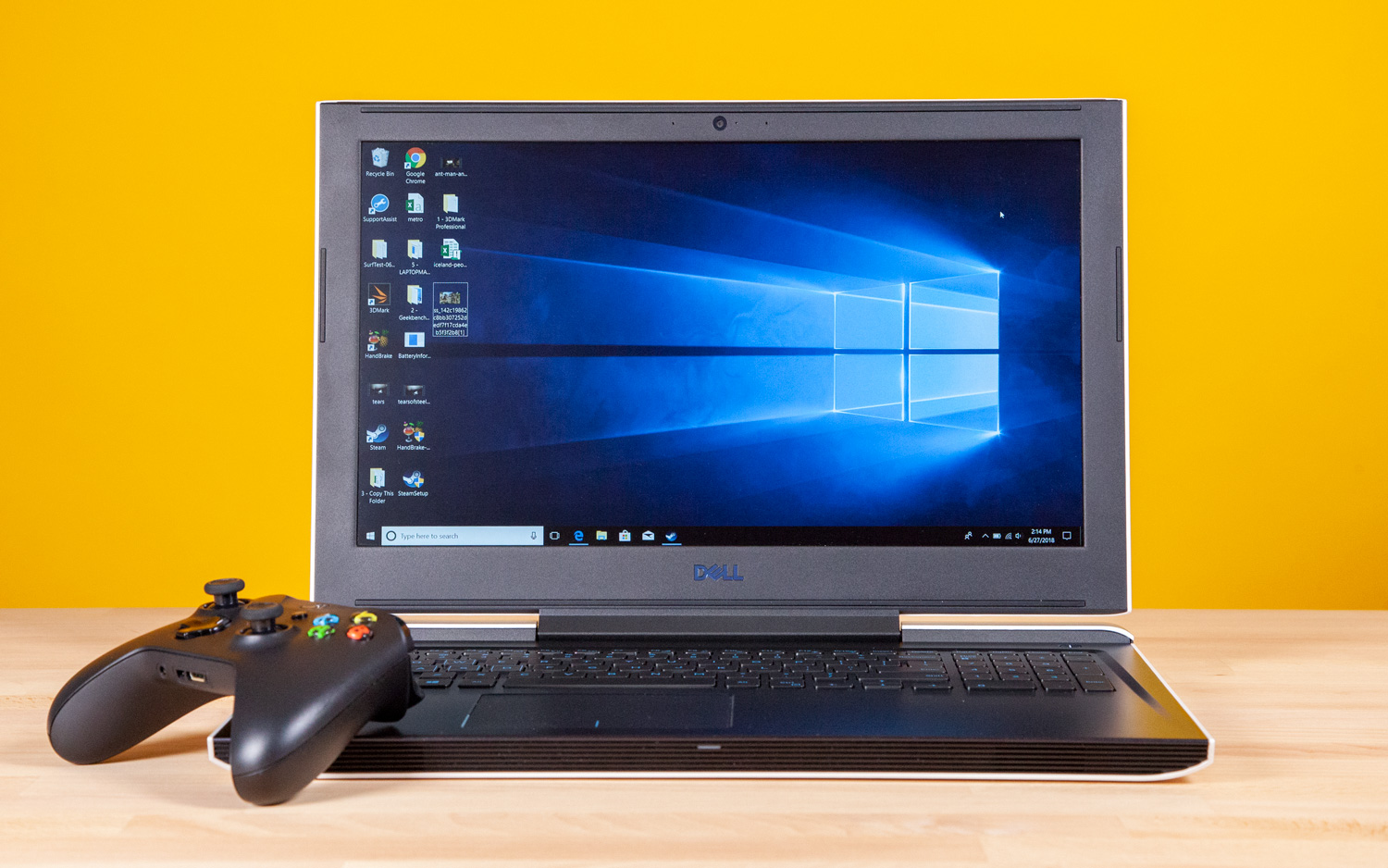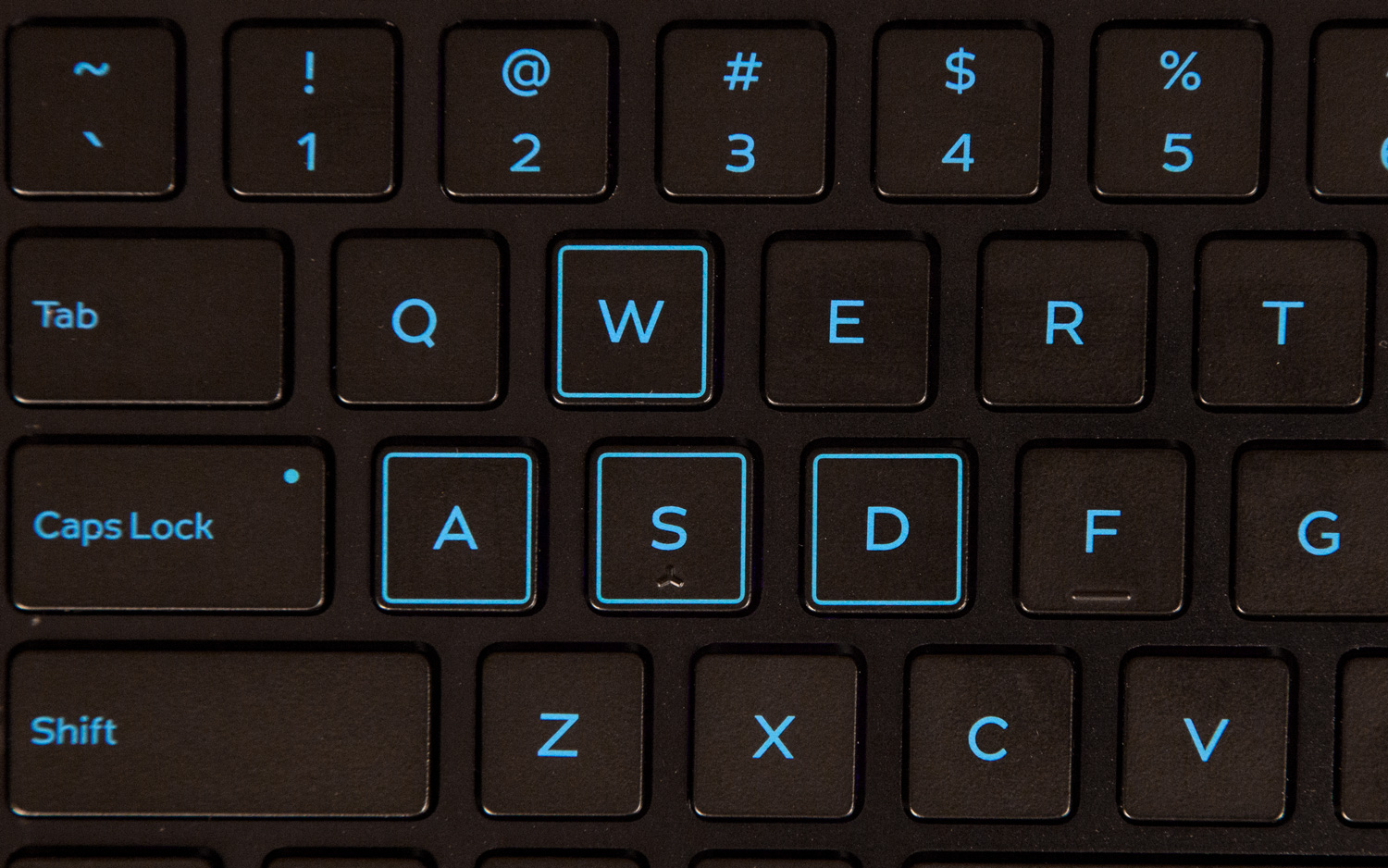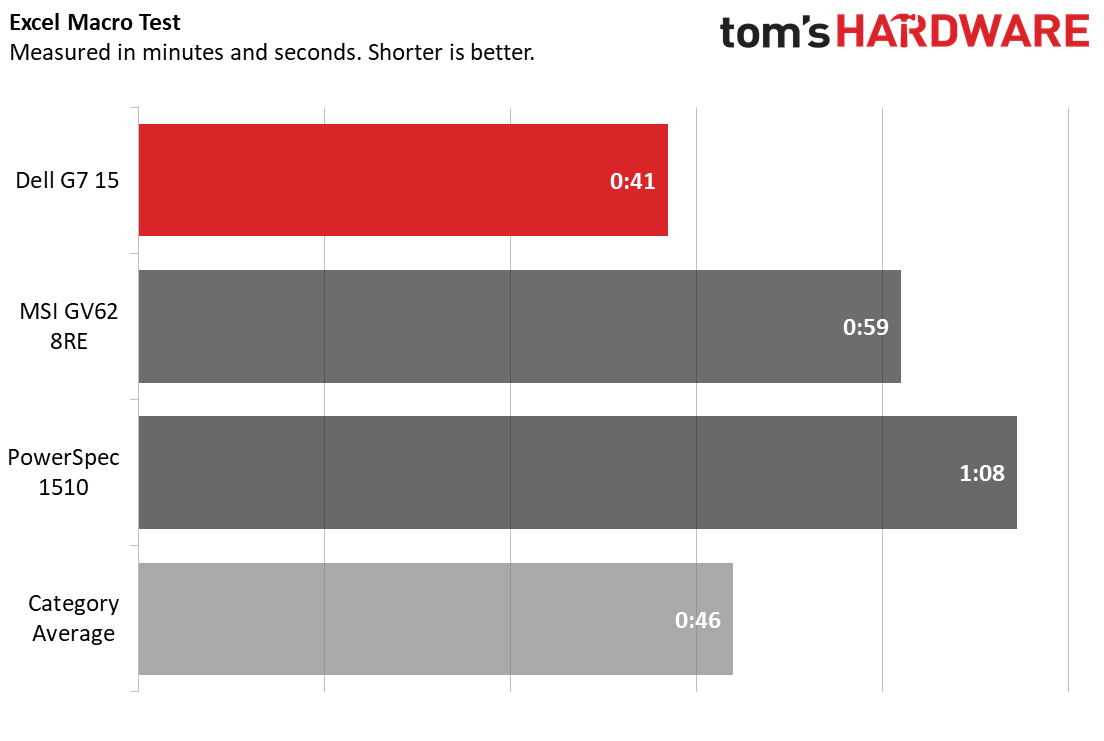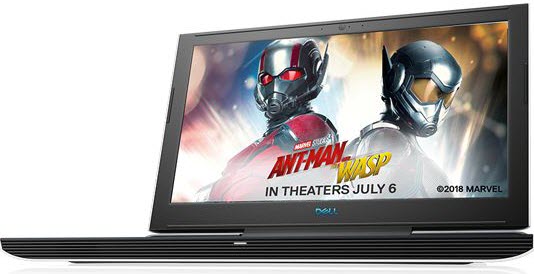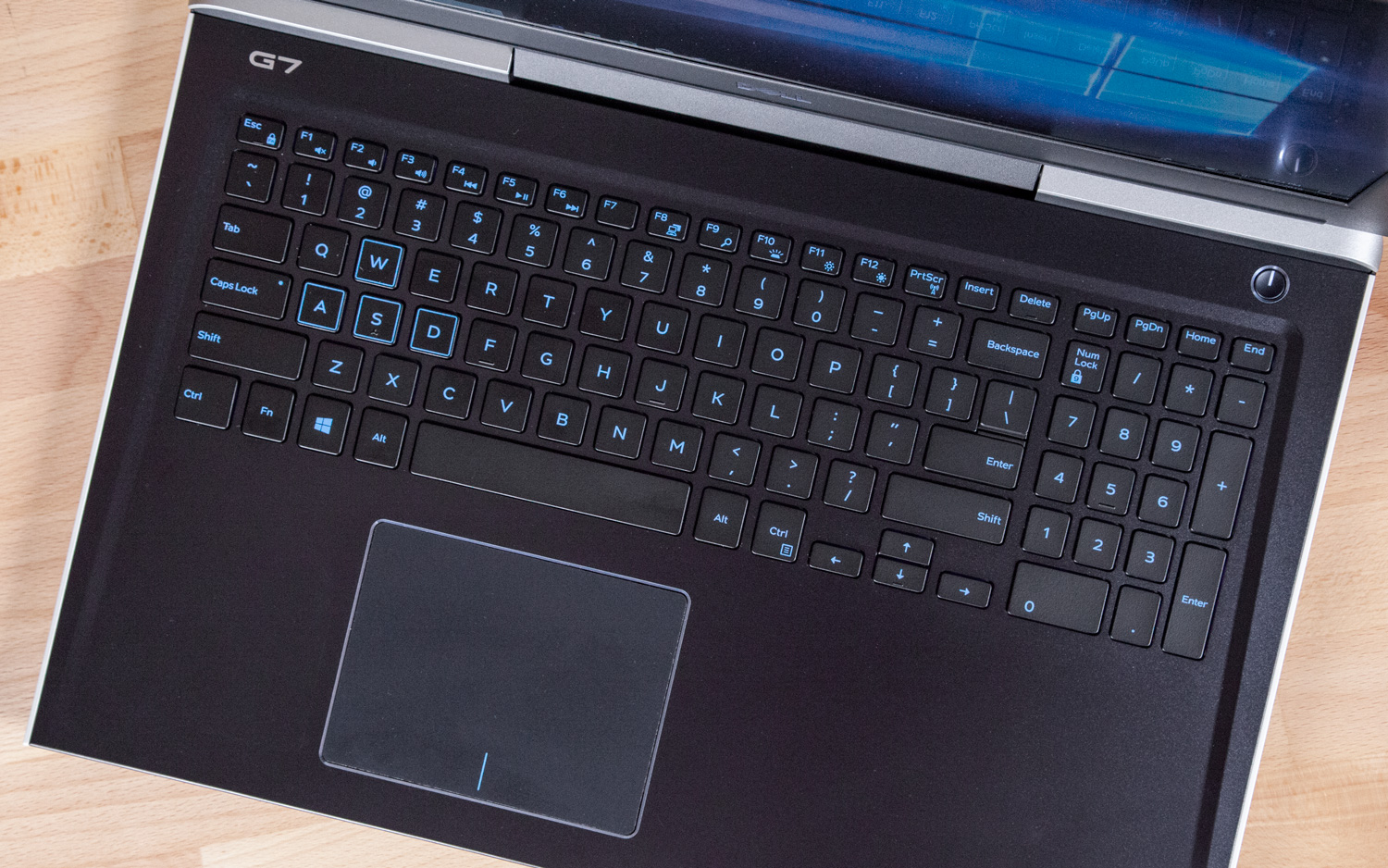Tom's Hardware Verdict
The Dell G7 15 is a looker and an easily upgradeable gaming laptop, but its display is too dim and the keyboard is shallow.
Pros
- +
Good looks
- +
Easily upgradeable
- +
Solid performance
Cons
- -
Dim display
- -
Shallow keyboard
Why you can trust Tom's Hardware
Update (7/2/2019): We tested the Dell G7 15 2019 Gaming Laptop. Check out our review to see what has changed.
Dell’s new gaming laptops are going for style. The G7 15 ($849.99 to start, $1,049.99 as tested) is sleek in a fancy white and blue colorway and also sports up to an Nvidia GeForce GTX 1060 Max-Q CPU and an Intel Core i7-8750H for strong performance. And with just one screw to loosen to get in, it’s even easy to upgrade. But the laptop also suffers from a dim display and the keyboard is shallower than I like. That makes this laptop definitely worth considering for mid-level gamers on the go, but they’ll have to overcome a few shortcomings.
Design
I’ll give Dell this, the G7 is a handsome midrange machine. Sure, it’s kind of chunky, but it has a racecar aesthetic that I really dig. Our review unit came in the new alpine white color (you can get it in black too), with a silver hinge and Dell’s logo in a shiny blue. Considering how many gaming notebooks come in black and red, the G7 is refreshing. The very back has some black ventilation with blue fans inside (that’s some attention to detail right there!) with a G7 badge that looks like it belongs on a sports car. It doesn’t feel like a sports car, though; the lid is made of plastic.
When you lift the lid, though, you get a much more traditional setup. Inside, it’s black and blue. The 15.6-inch display is surrounded by an almost offensively thick bezel with a blue Dell logo. The keyboard is black with blue lettering and blue backlighting. I wish that Dell would have stuck with the white color scheme on the inside. Switching to black feels like a half measure. Unlike the lid, the deck is made of metal, and it feels far more premium. There’s another G7 badge on the upper right-hand corner of the deck.


The sides of the laptop feature just about every port I would expect. ON the right side are a Noble lock slot, power jack, Ethernet port, a USB 3.1 Type-A port and an SD card slot. On the left are the headphone jack, another two Type-A ports, Thunderbolt 3 and an HDMI output.
At 6.3 pounds and 15.3 x 10.8 x 0.9 inches, the G7 is a bit chunky. The Acer Predator Helios 300 is a slight 5.5 pounds and 15.4 x 10.5 x 1.5 inches and MSI’s GV62 8RE is 5 pounds and 15 x 10. X 1.2 inches. The PowerSpec 1510 is heavier, weighing in at 6.5 pounds and 15.3 x 10.8 x 1.3 inches.
Specifications
| Display | 15.6” FHD (1920 x 1080) IPS |
| CPU | Intel Core i7-8750H |
| Graphics | Nvidia GeForce GTX 1060 with Max-Q Design (6GB GDDR5) |
| Memory | 16GB DDR4-2666MHz |
| SSD | 128GB SATA SSD |
| HDD | 1TB 5,400-RPM |
| Optical | ✗ |
| Networking | 802.11ac 2x2 Wi-Fi, Ethernet jack |
| Video Ports | HDMI |
| USB Ports | (3) USB 3.1, Thunderbolt 3 |
| Audio | 2x speakers, headphone jack, microphone jack |
| Camera | 720p webcam |
| Battery | 56 Whr battery |
| Power Adapter | 180W |
| Operating System | Windows 10 Home |
| Dimensions (WxDxH) | 15.3 x 10.8 x 0.9 inches |
| Weight | 6.3 pounds |
| Price (as configured) | $1,049.99 |
Gaming, Graphics and VR
The G7’s Nvidia GeForce GTX 1060 with Max-Q Design with 6GB of GDDR5 video memory will let you play most intensive games, though not always at their highest settings. When I played Middle-earth: Shadow of War at 1080p and Very High settings, it ran between 53 and 56 frames per second, but slowed down to 45 fps when a huge number of orcs attacked as I tried to defend a fort. When I bumped it down to 1080p and High settings, it ran between 64 and 66 fps, and dropped down to about 55 fps during intense combat.
Get Tom's Hardware's best news and in-depth reviews, straight to your inbox.
The laptop played Rise of the Tomb Raider (1080p, Very High) at 35 fps, a frame ahead of the 34-fps mainstream gaming average and on par with the MSI (36 fps, GTX 1060 6GB). The PowerSpec scored higher (56 fps, with a stronger GTX 1070 8GB), as did the Predator (67 fps, GTX 1060 6GB).
It kept up with the pack on Hitman (1080p, Very High with DirectX 12) at 63 fps. That’s just behind the average (67 fps) and Predator (64 fps), but ahead of the MSI (51 fps) and PowerSpec (60 fps).
On Grand Theft Auto V, (1920 x 1080, Very High), the G7 ran at 45 fps, below the 55-fps average as well as the MSI (48 fps), Predator (49 fps) and PowerSpec (60 fps).
It earned a score of 6.3 on the SteamVR Performance test, which is above average (5.6), but not as strong as the Predator (7.1), MSI (7.3) or PowerSpec (11).
Performance
With its 2.2-GHz Intel Core i7-8750H CPU, 16GB of RAM, a 128GB SATA SSD and a 1TB, 5,400-rpm HDD, our review configuration of the G7 is no pushover. I had 30 tabs open in Google Chrome, including one streaming a 1080p episode of “The Daily Show with Trevor Noah,” without any lag.
On Geekbench 4, the G7 notched a score of 19,516, surpassing the mainstream gaming average (16,156), the PowerSpec (14,223, Core i7-7700HQ), MSI GV52 8RE (13,689, Core i5-8300H) and Predator Helios 300 (13,587, Core i7-7700HQ).
It took 41 seconds for the G7 to pair 65,000 names and addresses in our Excel test, beating the average (0:46), MSI (0:59) and PowerSpec (1:08).
The G7 took 50 seconds to copy 4.97GB worth of mixed-media files, which is slower than average (0:30), the Predator (0:27), MSI (0:41) and PowerSpec (0:13).
On our Handbrake video editing test, the G7 transcoded a 4K video to 1080p in 10 minutes and 40 seconds, which is speedier than the average (12:01), MSI (13:09) and PowerSpec (14:00).
We also tested the Dell G7 for sustained performance. We ran the Metro: Last Light benchmark 9 times continuously (approximately 30 minutes) and found that the frame rate was slightly erratic. It tended to stay steady with an average framerate around 42 fps. The average CPU temperature during the benchmark was 82.6 degrees Celsius (180.7 degrees Fahrenheit). The average clock speed was 3.8GHz.
Display
The 15.6-inch, 1080p IPS display on the G7 is perhaps its biggest weak point. It’s dim and bland, and games and media just don’t stand out the way they should. When I watched a 1080p trailer for Ant-Man and The Wasp, I found myself mashing the F12 key to brighten the display, only to be dismayed that I couldn’t make it any more luminous. Some colors, like the yellow accents in The Wasp’s costume, were almost impossible to make out, and characters in any dark scene appeared almost entirely in shadow.
When I played Middle-earth: Shadow of Mordor, there was some unfortunate screen tearing, and the G7’s issue with shadows persisted. While a blazing orange fire popped, any area in shadow washed out all color, like the red in Talion’s outfit.
Dell’s display covers just 62 percent of the sRGB color gamut, well below the mainstream gaming average (107 percent) the PowerSpec (113 percent), MSI (72 percent) and Predator (81 percent).
It’s also dim at 232 nits. The average is 298 nits and the PowerSpec is even brighter at 306 nits. The MSI measured 240 nits and the Predator was a dimmer 226 nits.
Keyboard and Touchpad
I wish that the G7’s keyboard had a bit more substance. It’s on the shallow side, with keys measuring between 0.9 and 1 millimeters of travel (it wasn’t consistent throughout the keyboard). The keys require 61 grams of force to press. That didn’t keep me from typing my usual 112 words per minute on the 10fastfingers.com typing test, but I had a 3 percent error rate rather than my usual 2 percent.
The 4.1 x 3.1-inch Windows precision touchpad is nice and spacious. It’s smooth and instantly responded to two-finger scrolling, and four-finger swipes to switch between desktops.
Audio
I’ll give the G7 this: it gets loud. The laptop had no issue filling a mid-sized conference room with sound when I listened to Zedd’s “The Middle.” While the vocals and guitars were clear, keys and synths weren’t as strong. I was able to make some adjustments to the bass and details dials in the preinstalled Waves MaxxAudio Pro, which did help a bit and also gave a bit more depth to the drums.
When I played Middle-earth: Shadow of War, it was nice and loud, and I could even make out subtle sounds like footsteps and low orc grunts.
Upgradeability
It’s extremely easy to upgrade the G7’s RAM and storage. Dell recommends using a Phillips head #1 screwdriver. A plastic scribe can be helpful for getting the bottom off. All you have to do is loosen a single screw. While Dell’s manual says you can remove the base with your fingers, I used a plastic scribe to get it off. And that’s it: the two RAM slots were immediately available to me (in our configuration, both had a SODIMM). Those can be removed with just your fingers.
Removing the hard drive requires moving the hard-drive cable, pulling out the four screws to remove the bracket, and removing four more screws to get the bracket off of the cable. Then you place the new storage in the bracket and reverse the process.
A single screw holds the M.2 SSD in. You can just remove the screw, replace the SSD, and be done. The service manual lists a drive shield, though there wasn’t one in our unit. If your unit is like ours, which game with a 128GB SATA SSD, this makes it simple to replace it with a faster NVMe SSD further down the line.
Battery Life
Gaming laptops rarely last all day, and this is no exception. The G7 ran for 5 hours and 39 minutes on our battery test, which continuously browses the web, videos and graphics tests at 150 nits of brightness. That’s higher than the mainstream gaming average of 3:35 and the MSI’s 2:05, but slightly lesser than the Predator (6:01).
Heat
Before gaming, the G7 stays cool. After streaming 15 minutes of HD video from YouTube, it measured 78 degrees Fahrenheit on the touchpad, 90 degrees between the G and H keys and 92.5 degrees on the underside.
While playing Middle-earth: Shadow of War, the touchpad maintained the same temperature, but the keyboard climbed to 96 degrees and the bottom measured 115 degrees.
Webcam
The 720p webcam on the G7 is decent, but not amazing. In a photo I took in our office, my hair and shirt are both slightly blurry, though my face was sharp and clear. The colors in my brown stripes on my gray shirt were color accurate.
Software and Warranty
Dell has packed the G7 with software of mixed utility. Dell Mobile Connect lets you send and receive texts from your phone (and control your phone from your PC if you’re on Android). If you create a new Dropbox account on the G7, you get 20GB of free storage from one year. SmartByte lets you prioritize what gets to use your network’s bandwidth (Killer Control Center, also on board, lets you do this if you upgrade to Killer Wireless networking).
The bloat you’ll probably want to uninstall includes Netflix and McAfee Security. There’s also the usual junk that comes in every copy of Windows, like two different versions of Candy Crush, Seekers Notes: Hidden Mystery, Bubble Witch 3 Saga and LinkedIn.
The Dell G7 15 comes with a 1-year warranty.
Configurations
The Dell G7 15 I reviewed costs $1,049.99 and came in alpine white with an Intel Core i7-8750H CPU, 17GB of RAM, a 128GB SSD, 1TB, 5,400-rpm HDD and an Nvidia GeForce GTX Max-Q GPU with 6GB of GDDR5 VRAM.
The base model is $849.99 and comes armed with an Intel Core i5-8300H CPU, 8GB of RAM, a 1TB, 5,400-rpm HDD with 8GB cache and an Nvidia GeForce GTX 1050 GPU with 4GB of VRAM. It comes in either licorice black or alpine white.
There are various configuration options in between, as well as some more powerful ones. The line tops out at $1,599.99 with a Core i9-8950HK, but the same RAM, graphics and storage options.
Bottom Line
The Dell G7 15 breathes new life into Dell’s mainstream gaming lineup, with sleek looks in new colors. It doesn’t just look good; It offers strong performance for the price and is extremely easy to upgrade.
But the display is dim and not colorful enough for my liking, and the keyboard is inconsistent and on the shallow side.
For the price, you may also want to consider the 15-inch Acer Predator Helios 300. For $1,049, you get a full-size GTX 1060 GPU and similarly simple upgrading. The keyboard isn’t showstopping, but it’s better than the one on the G7. The Predator's display, however, is slightly dimmer than even the G7’s. It also runs a 7th-Gen Intel CPU, so you lose some productivity performance.
But the G7 15, one of the first in Dell’s new G-Series of laptops, is a step in the right direction with refined design and solid performance overall.
MORE: Best Gaming Laptops
MORE: Gaming Laptop Previews
MORE: All Laptop Content

Andrew E. Freedman is a senior editor at Tom's Hardware focusing on laptops, desktops and gaming. He also keeps up with the latest news. A lover of all things gaming and tech, his previous work has shown up in Tom's Guide, Laptop Mag, Kotaku, PCMag and Complex, among others. Follow him on Threads @FreedmanAE and BlueSky @andrewfreedman.net. You can send him tips on Signal: andrewfreedman.01
-
rasunin i stumbled upon this youtube video of a thai person reviewing the Dell G7 (https://www.youtube.com/watch?v=3D261De7Rg0). to my surprise, the keyboard has white print instead of blue. it looked so much better!! (and clearer for the eyes too)Reply -
spagafus Other stuff to uninstall:Reply
- Smartbyte software.
- Any Rivet Networks software or drivers.
Same if you have a Dell 7577 series. The Intel cards on these laptops work great without the so called "optimizations" that software is supposed to deliver. What you do get with Smartbyte/Rivet is inconsistent throughput and weird latency problems. -
10tacle Several thoughts on this having owned two Dell gaming laptops over the past 12 years (which I will never do again to be explained last). First the good, then the bad:Reply
1) Great price point for a GTX 1060 6GB laptop. Most at that point are 3GB versions from what I've seen.
2) Love the blue keyboard backlight. More soothing when gaming at night in low light levels.
3) Battery life is spectacular.
Now the bad:
1) That thick display bezel reminds me of a laptop or monitor made in the mid-00s. Fail.
2) Poor IPS display. Fail. I wonder what calibration can save it.
3) Lame 128GB SSD and 1TB 5200RPM HDD. Not a fail, but that requires at least an upgrade to a 2TB HDD long term for Steam and GOG games and preferably to a 7200RPM Western Digital Black.
The keyboard may not fit all preferences for everyone, but that's a laptop for you. I used a separate mouse and keyboard with my gaming laptops and connected them to either a PC monitor or HDTV when portable gaming like at a hotel or home of a relative on a holiday visit. That said, these things are so expensive for portable gaming and performance I decided to just go back to console (PS3/4). I've had my PS4 for four years now and a $1,000+ gaming laptop would have had to have been replaced at least once in that period to play newer games at playable frame rates.
Consoles > gaming laptops in bang for the buck and smart money long term. Totally different than desktop PCs where you can keep a four year old Intel chipset and throw in a new Nvidia GPU upgrade to play newer games at high quality settings. -
susanmwhite The Dell G7 15 breathes new life into Dell’s mainstream gaming lineup, with sleek looks in new colors. It doesn’t just look good; It offers strong performance for the price and is extremely easy to upgrade.LOOK MORE INTRESTING TECH.........http://www.precandy.com/Reply -
elcibernator I saw in some websites that some equipment brought a aoutronic with better quality.Reply
Sorry for my English. -
elcibernator I saw in some websites that some equipment brought a aoutronic monitor with better quality.Reply
Sorry for my English. -
joshuabilkey1 I was wondering what the contrast and brightness values were for the 4k model. How does it compare to the 1080p model reviewed?Reply
